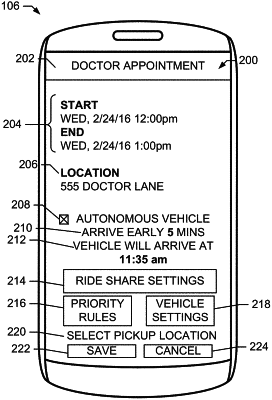| CPC G06Q 10/1095 (2013.01) [G05D 1/0088 (2013.01); G05D 1/0285 (2013.01); G08G 1/005 (2013.01); G08G 1/202 (2013.01); G06Q 50/30 (2013.01)] | 19 Claims |

|
1. An apparatus comprising:
memory;
machine readable instructions; and
processor circuitry to execute the machine readable instructions to:
determine that a calendar request for an autonomous vehicle is associated with a location or a route previously associated with the autonomous vehicle, the route associated with the location, the calendar request to be generated via a user interface application;
generate a predicted request for the autonomous vehicle in response to the determination that the calendar request is associated with the location or the route previously associated with the autonomous vehicle;
cause the user interface application to auto-populate a vehicle request field of the user interface application based on the generation of the predicted request for the autonomous vehicle;
cause the user interface application including the populated vehicle request field to be output for display;
detect confirmation of the predicted request based on a first user input received via the user interface application when the user interface application includes the populated vehicle request field;
in response to the confirmation, cause the user interface application to output a prompt for a user to select a pickup position at the location;
identify the pickup position based on a second user input via the user interface application; and
transmit an instruction to the autonomous vehicle to cause the autonomous vehicle to travel to the pickup position based on a time associated with the predicted request.
|